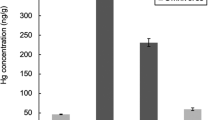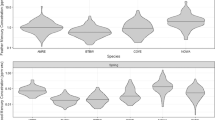Abstract
Passerines appear to have a greater sensitivity to mercury than other avian orders, and little data exists for mercury exposure in songbirds breeding at high latitudes. In this preliminary study, we examined mercury exposure in 12 migratory songbird species breeding in Denali National Park & Preserve, in subarctic interior Alaska. Overall, we analyzed 343 feather samples collected in 2015–2017 for their total mercury content. Mercury levels found in feathers indicates exposure during the period of feather growth, which we assume largely took place on the breeding ground. In this limited sample of songbird feathers, mercury concentrations ranged from near zero to 6.34 μg/g. Most species sampled showed relatively low mercury, but some individuals had high enough concentrations to be subject to adverse physiological and behavioral effects. There was an indication that mercury concentrations of breeding songbirds may vary by diet composition, with non-invertivorous species possibly tending towards lower mercury concentrations. Overall, however, the degree of mercury exposure observed was low for songbirds breeding in the subarctic. Further examination would prove useful in clarifying mercury exposure and ecological relationships in this under-studied region.


Similar content being viewed by others
References
Ackerman JT, Eagles-Smith CA, Herzog MP, Hartman CA, Peterson SH, Evers DC, Jackson AK, Elliott JE, Vander Pol SS, Bryan CE (2016) Avian mercury exposure and toxicological risk across western North America: a synthesis. Sci Total Environ 568:749–769
Agusa T, Matsumoto T, Ikemoto T, Anan Y, Kubota R, Yasunaga G, Kunito T, Tanabe S, Ogi H, Shibata Y (2005) Body distribution of trace elements in Black-tailed Gulls from Rishiri Island, Japan: Age-dependent accumulation and transfer to feathers and eggs. Environ Toxicol Chem 24:2107–2120
AMAP (2011) AMAP Assessment 2011: Mercury in the Arctic. Arctic Monitoring and Assessment Programme (AMAP), Oslo, Norway, p 207
AMAP/UNEP (2015) Global Mercury Modelling: Update of Modelling Results in the Global Mercury Assessment 2013. Arctic Monitoring and Assessment Programme, Oslo, Norway/UNEP Chemicals Branch, Geneva, Switzerland, p 36
Bearhop S, Ruxton G, Furness RW (2000) Dynamics of mercury in blood and feathers of Great Skuas. Environ Toxicol Chem 19:1638–1643
Braune BM (1987) Comparison of total mercury levels in relation to diet and molt for nine species of marine birds. Arch Environ Contam Toxicol 16:217–224
Brasso RL, Cristol DA (2008) Effects of mercury exposure on the reproductive success of Tree Swallows (Tachycineta bicolor). Ecotoxicology 17:133–141
Cristol DA, Brasso RL, Condon AM, Fovargue RE, Friedman SL, Hallinger KK, Monroe AP, White AE (2008) The Movement of aquatic mercury through terrestrial food webs. Science 320:335
Dial RJ, Smeltz TS, Sullivan PF, R inas CL, Timm K, Geck JE, Tobin SC, Golden TS, Berg EC (2016) Shrubline but not treeline advance matches climate velocity in montane ecosystems of south-central Alaska. Glob Change Biol 22:1841–1856
Edmonds ST, Evers DC, Cristol DA, Mettke-Hofmann C, Powell LL, McGann AJ, Armiger JW, Lane OP, Tessler DF, Newell P, Heyden K, O’Driscoll NJ (2010) Geographic and seasonal variation in mercury exposure of the declining Rusty Blackbird. Condor 112:789–799
Evers DC, Burgess NM, Champoux L, Hoskins B, Major A, Goodale WM, Taylor RJ, Poppenga R, Daigle T (2005) Patterns and interpretation of mercury exposure in freshwater communities in northeastern North America. Ecotoxicology 14:193–221
Hallinger KK, Zabransky DJ, Kazmer KA, Cristol DA (2010) Birdsong differs between mercury-polluted and reference sites. Auk 127:156–161
Hallinger KK, Cornell KL, Brasso RL, Cristol DA (2011) Mercury exposure and survival in free-living tree swallows (Tachycineta bicolor). Ecotoxicology 20:39–46
Hawley DM, Hallinger KK, Cristol DA (2009) Compromised immune competence in free-living Tree Swallows exposed to mercury. Ecotoxicology 18:499–503
Henry KA, Cristol DA, Varian-Ramos CW, Bradley EL (2015) Oxidative stress in songbirds exposed to dietary methylmercury. Ecotoxicology 24:520–526
Herring G, Ackerman JT, Herzog MP (2012) Mercury exposure may suppress baseline corticosterone levels in juvenile birds. Environ Sci Technol 46:6339–6346
Honda K, Nasu T, Tatsukawa R (1986) Seasonal changes in mercury accumulation in the Black-eared Kite (Milvus migrans lineatus). Environ Pollut Ser A, Ecol Biol 42:325–334
Howell SNG (2010) Molt in North American Birds. Houghton Mifflin Harcourt, New York, NY, p 280
Howie MG, Jackson AK, Cristol DA (2018) Spatial extent of mercury contamination in birds and their prey on the floodplain of a contaminated river. Sci Total Environ 630:1446–1452
Jackson AK, Evers DC, Etterson MA, Condon AM, Folsom SB, Detweiler J, Schmerfeld J, Cristol DA (2011) Mercury exposure affects the reproductive success of a free-living terrestrial songbird, the Carolina Wren (Thryothorus ludovicianus). Auk 1284:759–769
Jackson AK, Evers DC, Adams EA, Cristol DA, Eagles-Smith C, Edmonds ST, Gray CE, Hoskins B, Lane OP, Sauer A, Tear T (2015) Songbirds as sentinels of mercury in terrestrial habitats of eastern North America. Ecotoxicology 24:453–467
Kobiela ME, Cristol DA, Swaddle JP (2015) Risk-taking behaviours in Zebra Finches affected by mercury exposure. Anim Behav 103:153–160
Lavoie RA, Jardine TD, Chumchal MM, Kidd KA, Campbell LM (2013) Biomagnification of mercury in aquatic food Webs: a worldwide meta-analysis. Environ Sci Technol 47:13385–13394
Lewis CA, Cristol DA, Swaddle JP, Varian-Ramos CW, Zwollo P (2013) Decreased immune response in Zebra Finches exposed to sublethal doses of mercury. Arch Environ Contam Toxicol 64:327–336
Ma Y, Perez CR, Branfireun BA, Guglielmo CG (2018a) Dietary exposure to methylmercury affects flight endurance in a migratory songbird. Environ Pollut 234:894–901
Ma Y, Branfireun BA, Hobson KA, Guglielmo CG (2018b) Evidence of negative seasonal carry-over effects of breeding ground mercury exposure on survival of migratory birds. J Avian Biol 49:3. https://doi.org/10.1111/jav.01656
Maddux SL, Cristol DA, Varian-Ramos CW, Bradley EL (2015) The Effect of Mercury on Baseline Corticosterone in a Breeding Songbird. Bull Environ Contam Toxicol 94:135–139
Mizel JD, Schmidt JH, McIntyre CL, Roland CA (2016) Rapidly shifting elevational distributions of passerine species parallel vegetation change in the subarctic. Ecosphere 7(3):e01264. https://doi.org/10.1002/ecs2.1264
Newton I (2008) The Migration Ecology of Birds. Academic Press, Oxford, UK, p 984
Perkins M, Ferguson L, Lanctot RB, Stenhouse IJ, Kendall S, Brown S, Gates HR, Hall JO, Regan K, Evers DC (2016) Mercury exposure and risk in breeding and staging Alaskan shorebirds. Condor: Ornithological Appl 118:571–582
Phillips LM, McIntyre CL, Weidensaul S, Stenhouse IJ (2015) Critical Connections Program for Migratory Birds in Alaska: 2015 Program Activities. Natural Resource Report NPS/DENA/NRR–2015/1087. National Park Service, Fort Collins, CO, USA, p 18
Provencher JF, Mallory ML, Braune BM, Forbes MR, Gilchrist HG (2014) Mercury and marine birds in Arctic Canada: effects, current trends, and why we should be paying closer attention. Environ Rev 22:244–255
Pyle P (1997) Identification Guide to North American Birds, Part I: Columbidae to Ploceidae. Slate Creek Press, Bolinas, CA, p 732
R Core Team (2017) R: A language and environment for statistical computing. R Foundation for Statistical Computing, Vienna, Austria. http://www.R-project.org/
Rimmer CC, McFarland KP, Evers DC, Miller EK, Aubrey Y, Busby D, Taylor RJ (2005) Mercury concentrations in Bicknell’s thrush and other insectivorous passerines in montane forests of northeastern North America. Ecotoxicology 14:223–240
Rimmer CC, Miller EK, McFarland KP, Taylor RJ, Faccio SD (2010) Mercury bioaccumulation and trophic transfer in the terrestrial food web of a montane forest. Ecotoxicology 19:697–709
Roland CA, Stehn SE (2014) Denali repeat photography project reveals dramatic changes: a drier, woodier, and more densely vegetated park. Alaska Park. Science 12:68–71
Scheuhammer AM, Meyer MW, Sandheinrich MB, Murray MW (2007) Effects of environmental methylmercury on the health of wild birds, mammals, and fish. AMBIO 36:12–19
Scheuhammer A, Braune B, Chan HM, Frouin H, Krey A, Letcher L, Loseto L, Noël M, Ostertag S, Ross P, Wayland M (2015) Recent progress on our understanding of the biological effects of mercury in fish and wildlife in the Canadian Arctic. Sci Total Environ 509-510:91–103
Shuster PF, Schaefer KM, Aiken GR, Antweiler RC, Dewild JF, Gryziec JD, Gusmeroli A, Hugelius G, Jafarov E, Krabbenhoft DP, Liu L, Herman‐Mercer N, Mu C, Roth DA, Schaefer T, Striegl RG, Wickland KP, Zhang T (2018) Permafrost stores a globally significant amount of mercury. Geophys Res Lett 45:1463–1471
Stern GA, Macdonald RW, Outridge PM, Wilson S, Chetelat J, Cole A, Hintelmann H, Loseto LL, Steffen A, Wang F, Zdanowicz C (2012) How does climate change influence Arctic mercury? Sci Total Environ 414:22–42
Townsend JM, Driscoll CT, Rimmer CC, McFarland KP (2014) Avian, salamander, and forest floor mercury concentrations increase with elevation in a terrestrial ecosystem: enhanced high-elevation mercury accumulation. Environ Toxicol Chem 33:208–215
UNEP (2013) Global Mercury Assessment 2013: Sources, Emissions, Releases and Environmental Transport. United Nations Environmental Programme Chemicals Branch, Geneva, Switzerland, p 44
U.S. EPA (2007) Method 7473: Mercury in solids and solutions by thermal decomposition, amalgamation, and atomic absorption spectrometry. United States Environmental Protection Agency, Washington, DC, p 17
Varian-Ramos CW, Swaddle JP, Cristol DA (2014) Mercury reduces avian reproductive success and imposes selection: An experimental study with adult- or lifetime-exposure in Zebra Finch. PloS ONE 9(4):e95674
Whitney M, Cristol D (2017) Rapid depuration of mercury in songbirds accelerated by feather molt. Environ Toxicol Chem 36:3120–3126
Wickham H (2009) ggplot2: Elegant Graphics for Data Analysis. Springer-Verlag, New York, NY, p 276
Wiener J, Krabbenhoft D, Heinz GH, Scheuhammer A (2003) Ecotoxicology of Mercury. In: Hoffman D, Rattner B, Burton G, Cairns J (eds). Handbook of Ecotoxicology. CRC Press, Boca Raton, FL, p 409–463
Wilman H, Belmaker J, Simpson J, de la Rosa C, Rivadeneira MM, Jetz W (2014) Elton Traits 1.0: Species-level foraging attributes of the world’s birds and mammals. Ecology 95:2027
Wolfe MF, Schwarzbach S, Sulaiman RA (1998) Effects of mercury on wildlife: a comprehensive review. Environ Toxicol Chem 17:146–160
Acknowledgements
We are extremely grateful to the National Park Service, Alaska Geographic, Denali Education Center, Murie Science and Learning Center, Camp Denali, and Biodiversity Research Institute for provided funding and/or in-kind support for the Critical Connections Program, and to Dave Schirokauer (NPS) for his continued support of this project. We are extremely grateful to Emily Williams and Kevin Regan for their attention to detail and critical assistance in the field and lab, respectively. For their persistence and practical approach in the field, we also thank Jill Boelsma, George Gress, Jason Reppert, Dan Gusset, Dave Merz, Cole Rankin, and Jordan Tippetts.
Funding
This study was funded by the National Park Service, Alaska Geographic, Denali Education Center, Murie Science and Learning Center, and Camp Denali.
Author information
Authors and Affiliations
Corresponding author
Ethics declarations
Conflict of interest
The authors declare that they have no conflict of interest.
Ethical approval
All applicable international, national, and/or institutional guidelines for the care and use of animals were followed. All samples collected in this study, as well as capture and handling, took place under applicable permits for wildlife research. All sampling followed protocols approved by the National Park Service Institutional Animal Care and Use Committee (Permit Number AKR_DENA_McIntyre_Birds_2015.A3).
Additional information
Publisher’s note Springer Nature remains neutral with regard to jurisdictional claims in published maps and institutional affiliations.
Rights and permissions
About this article
Cite this article
Stenhouse, I.J., Adams, E.M., Phillips, L.M. et al. A preliminary assessment of mercury in the feathers of migratory songbirds breeding in the North American subarctic. Ecotoxicology 29, 1221–1228 (2020). https://doi.org/10.1007/s10646-019-02105-2
Accepted:
Published:
Issue Date:
DOI: https://doi.org/10.1007/s10646-019-02105-2




